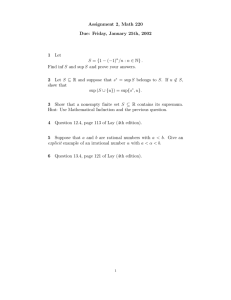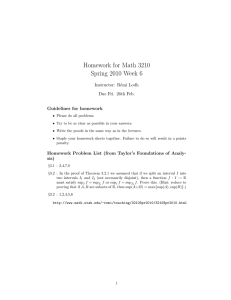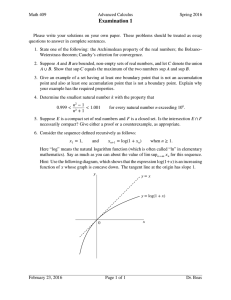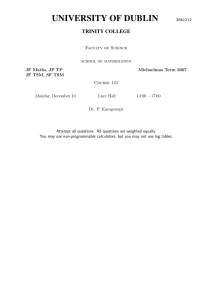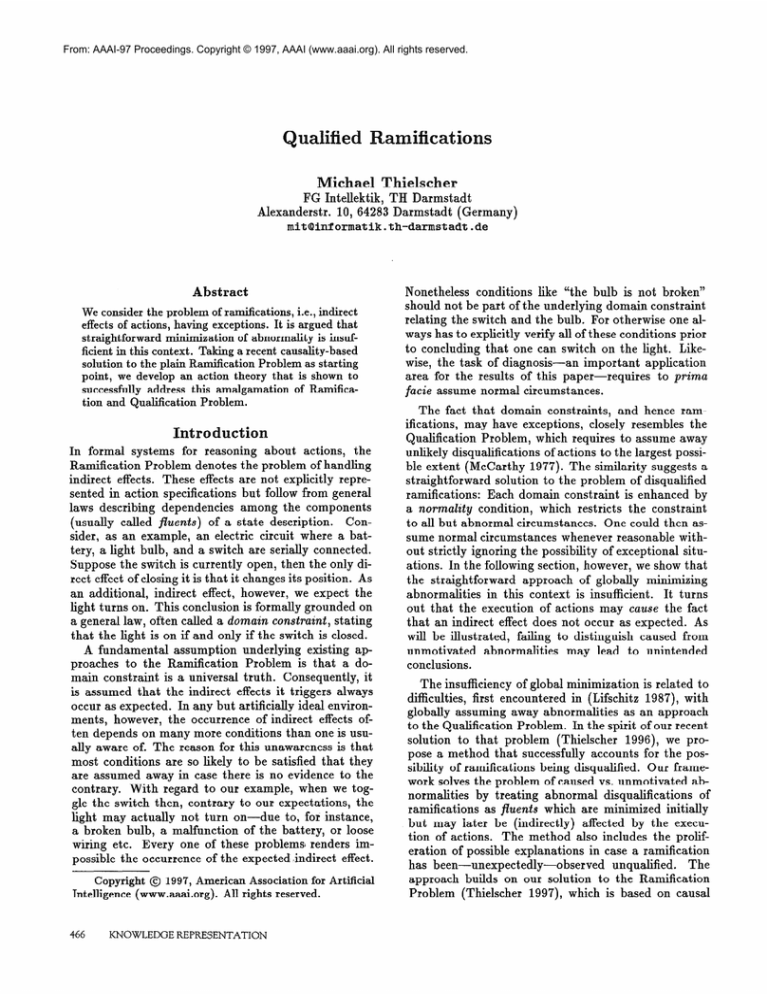
From: AAAI-97 Proceedings. Copyright © 1997, AAAI (www.aaai.org). All rights reserved.
Qualified
Michael
ifications
Thielscher
FG Intellektik,
TH Darmstadt
Alexanderstr.
10, 64283 Darmstadt
(Germany)
mit@informatik.th-darmstadt.de
Abstract
We consider the problem of ramifications,
i.e., indirect
effects of actions, having exceptions. It is argued that
straightforward
minimization
of abnormality
is insufficient in this context. Taking a recent causality-based
solution to the plain Ramification
Problem as starting
point, we develop an action theory that is shown to
successfully address this amalgamation
of Ramification and Qualification
Problem.
Introduction
In formal
systems for reasoning
about
actions,
the
Ramification
Problem
denotes the problem
of handling
indirect
effects. These effects are not explicitly
represented in action specifications
but follow from general
laws describing
dependencies
among the components
(usually
called j&e&s)
of a state description.
Consider, as an example,
an electric circuit where a battery, a light bulb, and a switch are serially connected.
Suppose the switch is currently
open, then the only direct effect of closing it is that it changes its position.
As
an additional,
indirect
effect, however,
we expect the
light turns on. This conclusion
is formally
grounded
on
a general law, often called a domain constraint,
stating
that the light is on if and only if the switch is closed.
A fundamental
assumption
underlying
existing
approaches
to the Ramification
Problem
is that a domain constraint
is a universal
truth.
Consequently,
it
is assumed that the indirect
effects it triggers always
occur as expected.
In any but artificially
ideal environments, however,
the occurrence
of indirect
effects often depends on many more conditions
than one is usually aware of. The reason for this unawareness
is that
most conditions
are so likely to be satisfied that they
are assumed away in case there is no evidence to the
contrary.
With regard to our example,
when we toggle the switch then, contrary
to our expectations,
the
light may actually
not turn on-due
to, for instance,
a broken bulb, a malfunction
of the battery,
or loose
wiring
etc. Every one of these problems
renders impossible the occurrence
of the expected indirect
effect.
Copyright
@ 1997, American Association for Artificial
Intelligence
(www.aaai.org).
All rights reserved.
466
KNOWLEDGE
REPRESENTATION
Nonetheless
conditions
like “the bulb is not broken”
should not be part of the underlying
domain constraint
relating
the switch and the bulb. For otherwise
one always has to explicitly
verify all of these conditions
prior
to concluding
that one can switch on the light.
Likewise, the task of diagnosis-an
important
application
area for the results of this paper-requires
to prima
j”acie assume normal circumstances.
The fact that domain
constraints,
and hence ramifications,
may have exceptions,
closely resembles
the
Qualification
Problem,
which requires to assume away
unlikely disqualifications
of actions to the largest possible extent (McCarthy
1977). The similarity
suggests a
straightforward
solution
to the problem
of disqualified
ramifications:
Each domain constraint
is enhanced
by
a normality
condition,
which restricts
the constraint
to all but abnormal
circumstances.
One could then assume normal circumstances
whenever
reasonable
without strictly ignoring
the possibility
of exceptional
situations. In the following
section, however, we show that
the straightforward
approach
of globally
minimizing
abnormalities
in this context is insufficient.
It turns
out that the execution
of actions may cause the fact
that an indirect
effect does not occur as expected.
As
will be illustrated,
failing to distinguish
caused from
unmotivated
abnormalities
may lead to unintended
conclusions.
The insufficiency
of global minimization
is related to
difficulties,
first encountered
in (Lifschitz
1987), with
globally
assuming
away abnormalities
as an approach
to the Qualification
Problem.
In the spirit of our recent
solution
to that problem
(Thielscher
1996), we propose a method that successfully
accounts for the possibility
of ramifications
being disqualified.
Our framework solves the problem
of caused vs. unmotivated
abnormalities
by treating
abnormal
disqualifications
of
ramifications
as fluents which are minimized
initially
but may later be (indirectly)
affected by the execution of actions.
The method
also includes
the proliferation of possible explanations
in case a ramification
has been-unexpectedly-observed
unqualified.
The
approach
builds on our solution
to the Ramification
Problem
(Thielscher
1997), which is based on causal
bat1
Figure
propagation
1:
bat2
An example
of indirect
Causing
electric
circuit.
effects.
isqualifkations
The ability
to assume away, by default,
exceptional
requires
some nondisqualifications
of ramifications
monotonic
feature.
For one might be forced to within the light of additional
indraw previous conclusions
formation.
This suggests the introduction
of ‘normality’ conditions
both to domain constraints
and for the
computation
of indirect
effects triggered
by these constraints.
Then by suitably
minimizing
abnormality,
we
achieve the desired behavior,
namely, that exceptions
are assumed away to the largest reasonable
extent. For
example,
taken as domain constraints
the formulas
7abl > [cZosed( swl) E light]
broken > abl
(1)
broken > Tlight
state, respectively,
that in any situation
the light is
on iff switch
swl is closed-but
only in case there is
no abnormality
with this regard;
that a broken bulb
is such an abnormality;
and that the broken bulb can
where we know
never shine. Now, suppose a situation
nothing
except that swl has just been closed. Then
minimizing
abnormality
allows us to conclude
that
cZosed(swi)
E light holds.
Thus any reasonable
solution
to the Ramification
Problem
should derive the
indirect
effect light. On the other hand, in a situation
where we know that the bulb is broken,
abl is derivable, hence cannot be assumed false. Then closing the
switch no longer
- turns on the light.
Generally,
assuming
away unlikely
exceptions
of
is, however, not as easy as in this simple
ramifications
example.
In particular,
just globally
minimizing
abbecome insufficient
to obtain
normalities
can quickly
the intended
conclusions.
To see why, consider the following extension
of our introductory
example (c.f. Figure 1). The light bulb is now involved in a second subcircuit consist&g
of another
switch,
sw2, and another
battery,
bata. Suppose further
that
bata, without
a
resistor
being involved .9 is too powerful
for our light
bulb so that the latter immediately
gets broken when
closing
swa-provided,
of course, the second battery
itself does not malfunction.
In conjunction
with the
formulas
in (l),, , the following
two domain
constraints
formalize
this extended
domain:
Tub2 > [cZosed( sw2) > broken]
(2)
muZfunc( but 2) > ub2
Consider,
now, a situation
where we only know that
both switches are open (cf. Figure 1). What would be
the predicted
outcome of closing sw2 followed by swl ?
Since nothing
hints at but2 malfunctioning,
we should
expect that cZosed( sw2) > broken be true and, hence,
broken
is an indirect
effect of closing
sw2. Consequently, closing swl afterwards
should fail to produce
light.
But what happens if abnormality
is globally
minimized in this scenario?
Obviously,
some abnormality
is
inevitable.
Thus one minimal
model is given by Tub2
with regard to the first action, and ubl with regard
to the second. This corresponds
to the intended
conclusion.
However, we can just as well assume the first
ramification
unqualified
(i.e., uba), which then would
avoid the necessity of assuming
a disqualification
of
the following
ramification
(i.e., TubI).
For if the bulb
does not break as a consequence
of toggling
swz, then
the light turns on as indirect
effect of toggling
swi afterwards.
This gives us a second, unintended
model,
where finally the light is on!
The reason for the second minimal
model
being
counter-intuitive
is not that we consider broken bulbs
more likely
than malfunctioning
batteries.
Rat her
what decisively
distinguishes
the two possible abnormalities
is that
ubl but not ub2 can easily be explained from the perspective
of causality.
Closing
sw2
along with all of its expected indirect
effects causes the
fact that the relation
cZose&(swl)
E light no longer
holds, whereas an abnormal
disqualification,
ub2, of
cZosed(sw2) > broken comes out of the blue in the unintended
minimal
model.
One even tends to not call
the former abnormal
since being unable to turn on the
light after having destroyed
the bulb is, after all, what
one would normally
expect.
This situation
resembles
a problem
in the context of the Qualification
Problem
if the latter is approached
without
supporting
the distinction
between caused and unmotivated
disqualifications of actions (Lifschitz
1987). The reader may also
notice the similarities
to the well-known
Yale Shooting
problem
(Hanks and McDermott
1987): A gun that becomes magically
unloaded while waiting deserves being
called abnormal,
whereas causality
explains
the death
of the turkey if being shot at with a loaded gun.
An alternative
to global minimization
is minimizing
chronologically,
following
the ideas of chronological
ignorance (Shoham
1988). Putting
off abnormalities
as
long as possible indeed produces
the unique intended
model for our example
scenario.
On the other hand,
chronological
minimization
is known to have chronic
problems
with domains
involving
non-determinism.
Suppose,
for example,
we learn that
while
waiting somebody
non-deterministically
closes SW2, which
would cause an abnormality
(viz. the bulb breaks).
Putting
off abnormalities
as long as possible,
chronological minimization
supports
the conclusion
that sw2
never gets closed, which is obviously
a conclusion
too
optimistic,
hence unintended.
REASONING
ABOUT
ACTION
467
In the following,
we develop
a suitable
account of
disqualified
ramifications
which respects the possibility
of abnormalities
being caused.
The approach
builds
on our recently
proposed
solution
to the Ramification
Problem
(Thielscher
1997).
A brief recapitulation
of
this method is next.
Causal
Relationshi
Any satisfactory
solution
to the Ramification
Problem
requires the successful treatment
of two major issues.
First, an appropriately
weakened
version of the general law of persistence
needs to be developed
which
applies
only to those parts of the world description
that are unaffected
by the action’s
direct
and indirect effects. Second, while indirect
effects derive from
domain constraints,
not all logical consequences
of domain constraints
constitute
indirect
effects (Lifschitz
1990).
To meet these challenges,
our approach
described in (Thielscher
1997) takes the world description
obtained
through
generating
the direct effects of an action as a mere intermediate
result. Indirect
effects are
then accommodated
by the successive application
of
causaE relationships
until an overall satisfactory
successor state obtains.
In the following,
we recall the
formal
definitions
underlying
this approach.
Due to
space limitations
we restrict ourselves to propositional
fluents; for the general case as well as for more details
we refer the reader to (Thielscher
1997).
Definition
1
Let 3 be a finite set of symbols called
jluents.
A fluent literal is either a fluent
f E 3 or
its negation,
denoted by lf.
A set of fluent literals is
inconsistent
iff it contains some f E 3 along with lf,
and is a state iff it is maximally
consistent.
The elements
of an underlying
set of fluents can be
considered
atoms for constructing
(propositional)
formulas to allow for statements
about states. Each fluent
literal
and T (tautoEogy)
and I (contradiction)
are
fluent formulas,
and if F and G are fluent formulas
then so are F A G, F V 6, F > G, and F E G. The
notion
of fluent formulas
being true in a state S is
based on defining
a literal
& to be true if and only if
1 E S. Fluent formulas
which have to be satisfied in
all states that are possible in a domain are also called
domain
constraints.
Definition
2
Let A be a finite set of symbols called
actions.
An action law is a triple
(C, a, E) where C,
called condition,
and E, called effect, are consistent
sets of fluent literals
such that [C] = [E],l and where
a E JL. If S is a state, then an action law (C, a, E)
is appZicabZe in S iff C E S. The application
yields
(S \ C) u E.
Notably,
the resulting
set (S \ C) U E is a state if so
is S, but it may violate the underlying
domain
constraints.
‘If S is a set of fluent
literals,
then by [S]
set of fluents
occurring in S. That is, [C] =
and
E refer
to the same fluents.
468
KNOWLEDGEREPRESENTATION
we denote
[E] requires
the
C
3
Let 3 be a set of fluents. A causal relationship
is an expression
of the form E causes Q if @
where Qi is a fluent formula
and E and Q are fluent
literals.
Definition
The intended
reading is the following:
Under condition <P, the (previously
obtained,
direct or indirect)
effect E triggers the indirect
effect Q.
Causal
relationships
operate
on pairs
(S, E),
where
S denotes the current
state and E contains
all direct and indirect
effects computed
so far:
Definition
4
Let (S, E) be a pair consisting
of a
state S and a set of fluent literals
E, then a causal
relationship
e causes Q if fD is uppZicabZe to (S, E)
iff 4[, A le is true in S and E E E. Its application
yields the pair (S’ , E’) where S’ = (S \ {le})
U {Q)
and E’ = (E \ {TQ)) U {Q}.
If R is a set of causal
relationships,
then
by
(S, E) +
(S’, E’) we indicate that there are elements
in R whose successive application
to (S, E) yields
(S’, E’).
Now, suppose given a set of fluent literals
S as the
result of having computed
the direct effect E of an
action via Definition
2. Additional,
indirect
effects are
then accounted
for by (non-deterministically)
selecting and (serially)
applying
causal relationships
until a
state satisfying
the domain constraints
obtains.
Defmition
5
Let L
set of domain constraints,
tionships.
Furthermore,
and a E A.
A state
and a iff there exists
law (C, a, E) E fZ such
1. ((S \ C) u E, E)
2. S’ satisfies
Examplle
light,
1
broken).
AZ
be a set of action laws, D a
and R a set of causal relalet S be a state satisfying
D
S’ is a successor state of S
an applicable
(wrt.
S) action
that
(S’, E’)
for some
E’, and
D.
Let 3 =
The domain
{cZosed(swl),
constraints
cZosed(sw2),
cZosed(swl)
E light
closed (swa) > broken
broken > TZight
(3)
state what normally
holds in the circuit
depicted
in
Figure
1. All three formulas
are true in the state
S = {lcZosed(swl),
lcZosed(swz),
llight,
lbroken),
e.g.
The following
causal relationships
derive from
these domain constraints:2
cZosed(swl)
lcZosed(swl)
cZosed(sw2)
broken
2See (Thielscher
1997)
causal
relationships
from
tional
domain
knowledge
causes
causes
causes
causes
light
TZight
broken
TZight
if
if
if
if
on how to automatically
domain
constraints
as to potential
causal
T
T
T
T
(4)
extract
given
addiinfluences.
Let A = {toggZe(swl),
sists of the four action
((~cZosed(swl)},
( { cZosed( SW1 )},
({lcZosed(sw~)),
({cZosed(swa)),
toggZe(swz)},
laws
toggZe(swl),
h7&(
swl),
toggZe(swz),
toggZe(swz),
and
let
C con-
{cZosed(swl)))
{-zosed(
sw )) >
{cZosed(swa)))
{lcZosed(sw~)))
(5)
Then applying
action
toggZe(sw2)
to state S from
for instance,
yields
the intermediate
state
above,
S’ = {lcZosed(swl),
cZosed(swz), -light,
lbroben)which violates
the second domain
constraint
in (3).
Regarding
the state-effect
pair (S’, {cZosed(swz))),
we
can apply the third one of the causal relationships
depicted in (4), which results in the pair
({lcZosed(swl),
The first
successor
cZosed(sw2), llight,
broken),
{cZosed(swz),
broken)
component
of S and
satisfies (3),
toggZe(sw2).
hence
constitutes
)
a
A fundamental
assumption
underlying
our approach
to
the Ramification
Problem
is that domain
constraints
are universally
valid. This assumption
is carried over
to the causal relationships
that derive from a constraint.
As a consequence,
it is assumed that indirect
effects always occur as expected.
As argued, however,
the situation
might not be as ideal. Domain constraints
may have exceptions,
hence so do causal relationships.
Suppose
given a set of domain
constraints
D. In
order to account for exceptions
to these formulas,
we
first introduce,
for each d; E D, a unique ‘abnormality’
predicate
abi. Then constraint
di is replaced
by the
weaker formula
labi > di. a’his restricts the necessity
of di being true to states in which labi
holds-states
which are ‘normal’
with respect to di.
The modification
of domain constraints
transfers to
causal relationships.
Each E causes ,g if $ triggered
by constraint
da is replaced by E causes e if @Alabi.
That is to say, effect E causes indirect
effect e now
only under normal circumstances-if
there happens to
be an exception
to the underlying
domain constraints,
then the corresponding
ramification
is no longer expected.
Having admitted
exceptions
to domain
constraints,
the next step is to define the circumstances
under
which a particular
abnormality
occurs. This is accomplished by additional
constraints
each of which relates
some ubi to the conceivable
causes. In order that observed abnormalities
can be explained,
it is desirable
to equate an abnormality
with the disjunction
of all
known potential
reasons for its occurrence,
e.g.3
abl
= broken
V
muZfunc(
butI)
V
31nstead
of explicitly
providing
the
could
be implicitly
obtained
through
predicates
ab; in a given
set of domain
loose-wiring
“only-if”
part,
circumscribing
constraints.
(6)
this
the
a‘he purpose of introducing
conditions
of ‘normality’
with regard to domain constraints
is to not strictly exclude the possibility
of exceptions
to these constraints.
Since any exception
is considered
unlikely,
we do however wish to ignore it unless there is evidence
to the
contrary.
Abnormal
circumstances
should therefore
be
assumed
away to the largest reasonable
extent.
As
shown above, straightforward
minimization
of abnormality is insufficient
to this end because some abnormal disqualifications
of ramifications
may be expected
for reasons of causality.
To account for this, we represent any single abnormality
as a fluent.
As such,
abnormalities
may be (indirectly)
affected by the execution
of actions,
and otherwise
are subject
to the
general law of persistence.
The former allows us to expect an abnormality
whenever
it has been caused by
an action. Notice that formulas
such as (6) give rise to
indirect
effects if taken as domain constraints:
Whenever some cause for an abnormality
occurs as (direct or
indirect)
effect, then the abnormality
appears through
ramification.
Conversely,
if a cause disappears
and no
other cause holds, then the abnormality,
too, disappears, again through
ramification.
In order that abnormal
circumstances
are assumed
away if nothing
hints at their presence, the ‘abnormality’ fluents are considered
false by default only in the
initial
state. Persistence
then guarantees
normal
circumstances
as long as no actions are performed
which
affect the truth-value
of some fluent
ubi. Formally,
we
distinguish
among all fluents
3 those which describe
abnormalities,
the set of which is denoted
3&.
It is
required
that ubi E 3’b for any ubi, but other fluents
may represent
abnormal
circumstances
too, such as,
e.g., broken,
muZfunc(but~),
or loose-wiring.
When
searching
for models of a scenario
description,
those
are preferred
that declare false initially
as many fluents fab E 3&, as possible
according
to the observations that constitute
the scenario.
a‘he formal definition
of model preference
can be directly
adopted
from (Thielscher
1996):
efiniaisn
tion Res
such that
a”
=
6
An interpretation
is a partial
funcmapping
finite action sequences to states4
for each Te 2 0 and each action sequence
[%-,ak,ak+l],
a Res ([ 1) is defined
and satisfies the domain
constraints.
2. Res(u*)
is defined iff so is Res([ul, . . . , ak]) and
there is a successor of Res( [al, . . . , al,]) and ak+l.
3. If Res(u*)
is defined,
then it is a successor
of
Res([ul, . . . , ale]) and ak+l.
1
An observation
is an expression
F after
[al, . . . , a,]
where
F is a fluent formula
and al, e . . , a, are actions ( n >_ 0). The observation
holds in an interpretation
Res iff Res( [al, . . . , a,]) is defined and F is
true in that state.
4We
consider
a branching
time
structure.
REASONING ABOUT ACTION
469
A model for a set of observation
0 is an interpretation in which all observations
hold.
A model
Res
is preferred
iff there is no model
Res’ such that
a
Res’([])
n Fab s Res([])
f-7 %bIn the remainder
of this section we illustrate
how
our framework
successfully
addresses basic issues when
dealing
with disqualifications
of ramifications.
Although
no strictly
formal
claim is made, the following discussion
is meant to convince the reader that our
theory is suitable
as regards a variety of fundamental
aspects in this context.
Let us extend
Assuming
qualification
by default.
the set of fluents
3 used in Example
1 by abi, ab;l,
mu&nc(
b&l),
maZfunc( buta), and loose-wiring.
All
of these plus fluent
broken
shall belong to Tab. We
define the following
domain constraints
(see Figure 1):
lab1
ubl
lab2
ub2
labs
>
E
>
3
>
[cZosed(swl)
F light]
broken V muZfinc( but 1) V Zoose-wiring
[cZosed(swz)
> broken]
muZfunc(butz)
V loose-wiring
[broken > llight]
(7)
(8)
(9)
The very last formula
states that a broken bulb shining
Due to space restrictions
we
would be inexplicable.
only mention
four out of all the causal relationships
determined
by these constraints:
cZosed(swl)
broken
lbroken
causes
causes
causes
cZosed(sw2)
causes
light if TubI
ubl if T
TubI if lmuZfunc(but1)
Alloose-wiring
broken if lab2
(10)
(11)
(12)
(13)
deriving
from (7), (8), (8), and (9), respectively.
Suppose given the observation
lcZosed(swl)
A lcZosed(swa)
It is consistent
with this
initially
each fab E 3ab.
therefore
satisfies
laba
broken E Res([toggZe(swa)])
causal relationship
(13).
model the bulb is broken
is the intended
conclusion:
of constraint
(9) and of
c.f. (13), is assumed away
after
[]
(14)
observation
to assume false
Any preferred
model
Res
E Res([]).
Consequently,
given action laws (5) and
In words, in any preferred
after toggling
sw2 -which
Abnormal
disqualification
the ramification
it triggers,
by default.
Causing
disqualifications.
We just saw that any
preferred
model
Res of observation
(14) satisfies
broken
E Res( [toggZe( sw;z)]).
According
to causal
relationship
(ll),
b ro k en becoming
true determines
another
ramification,
namely,
ubl becoming
true in
Res ([toggle (sw 2)]). That is, the ramification
becomes
disqualified
which normally
turns on the light if swi
470
KNOWLEDGE
REPRESENTATION
gets closed. Thus any preferred
model Res of (14) satisfies TZight E Res( [toggZe( swz), toggZe( swl)]),
which
is the intended
conclusion
as argued at the beginning:
The disqualification
of domain constraint
(7) has been
obtained
as a side-effect
of, hence has been caused by,
performing
toggle (sw2).
Explaining
1 broken
disqualifications.
A Iloose-wiring
llight
Suppose
given
after
[]
after
[toggZe(swl)]
(15)
(16)
in addition
to observation
(14). Any model Res must
satisfy
ubl E Res([])
t o account for (16). Observation (15) implies
lbroken,
lloose-wiring
E Res([]).
Definition
6 requires
that
Res( [I) satisfy the underlying
domain
constraints,
in particular
(8); thus,
muZfunc( but 1) E Res( [I). That is to say, each preferred
model determines
a malfunction
of but 1 as explanation
for being unable to switch on the light via closing swi.
Minimizing
explanations.
Suppose we learn that
muZfunc(butl)
after
[I, then
ubl E Res([])
for any
model
Res according
to (8). Nonetheless
it is consistent to assume both
broken
and loose-wiring
be
false initially.
These, too, being abnormality
fluents,
we have lbroken,
TZoose-wiring
E Res([])
in any preferred model.
Thus, although
we know there must be
an abnormality
with the sub-circuit
involving
butI, we
still conclude,
by default, that bulb and wiring are ok.
Revoking
qualification.
Suppose we introduce
the
action of replacing
the broken bulb, specified by the action law ({broken},
replace, {-broken}).
As we have
seen, any preferred
model
Res of observation
(14)
satisfies
broken, ubl E Res([toggZe(sw2)]).
According
to (5), again toggling
sw2 opens this switch while
nothing
else changes,
that is, broken
and ubl remain true in Res([toggZe(swz),
toggZe(sw2)]).
Consequently,
the replace
action is applicable
to this state
with the effect that broken is false in the next state.
Then causal relationship
(12) determines
the ramification
TubI
(notice that both
lmuZfunc(butl)
and
~Zoose-wiring
hold initially
in preferred
models and
persist throughout
the entire process).
This implies
that the light could again be switched
on in the state
Res([toggZe(sw2),
toggZe(sw2), replace]).
This in turn
shows how a qualification
gets revoked as soon as its
cause (here: the broken bulb) disappears.
Non-deterministic
actions.
Recall
the scenario
discussed earlier where switch
sw2 may or may not
get closed while waiting.
Action
wait
being nondeterministic,
it is specified by two action laws whose
conditions
are not mutually
exclusive,
viz.
({lcZosed(sw2)},
(Chwait
913>
wait , {cZosed(sw2))
Suppose again given observation
(14).
tial values of the only non-abnormality
)
(17)
Since the inifluents
in
our domain
are specified
via this observation,
there
is a unique
preferred
initial
state Res( [I), namely,
{lcZosed(swl),
1czosed(sw2))
u {lfab
: fab E 3&}.
Among others, this state entails the (default)
assumption
labI,
that is, the light could be switched
on.
However,
performing
a wait action in Res([])
determines two possible successor states according
to (17):
one that is identical
to Res ([ I), and one where sw2
gets closed and, hence, the bulb breaks and abl becomes true (c.f. (13) and (11)).
Thus there are two
different
preferred
models
Resl and Res2 such that
TabI E Resl([wuit])
whereas
ubl E Res2([wuit]).
Due
to the latter,
it cannot
be concluded
that the light
can be switched
on after waiting,
which is the intended conclusion.
This shows that our framework,
in contrast
to chronological
minimization,
treats nondeterministic
information
appropriately,
namely,
the
cautious way.
Discussion
We have argued that both domain constraints
and the
ramifications
they trigger may have exceptions,
which,
however,
need to be assumed away by default.
We
have illustrated
that simple global minimization
of abnormalities
is insufficient
to this end because it fails to
distinguish
caused from unmotivated
disqualifications.
We then have developed
an action theory where abnormal
disqualifications
of ramifications
are taken as
fluents which are assumed false initially
but may be
indirectly
affected by the execution
of actions.
It has
been illustrated
how this allows to assume away exceptional circumstances
to a reasonable
extent-including
a proper distinction
of caused vs. unmotivated
abnormalities.
In addition,
our framework
supports the proliferation
of explanations
for observed disqualifications
of ramifications.
These explanations,
too, are minimized, and if a cause for a disqualification
disappears
then qualification
gets revoked.
Finally, our approach
to ramifications
with exceptions
has been shown not to
interfere
with handling
non-deterministic
information.
The work reported
here essentially
relies on our
causality-based
solution
to the Ramification
Problem described
in (Thielscher
1997).
Arguments
in
favor of this solution,
linked
with a through
comparison
to other approaches,
can be found in that
paper.
The problem
of ramifications
having
exceptions has received
little attention
in literature
up to
now, probably
because satisfactory
solutions
to the
Ramification
Problem
itself have not emerged
until
very recently.
To the best of the author’s
knowledge, the only existing
papers dealing with disqualifications
of ramifications
are (Baral
and Lobo 1996;
Zhang 1996). In both of them expressions
resembling
causal relationships
are allowed to be defeasible.
Neither of the approaches,
however, goes beyond defining
a notion
of successor state based on minimizing
abnormality.
Therefore,
if applied as they stand the two
approaches,
by producing
the unintended
model, im-
mediately
get caught in the causality
trap illustrated
with our key example depicted in Figure 1.
The action theory presented
in this paper was inspired by a solution
to the problem
of abnormal
disqualifications
of actions proposed
in (Thielscher
1996).
The latter also describes a provably
correct Fluent Calculus (HSlldobler
and Schneeberger
1990) realization
of that theory, which uses default
rules to encode the
assumptions
of ‘normality’.
This Fluent Calculus
encoding can straightforwardly
be adopted
to the theory proposed
in the present paper.
(Thielscher
1996)
also describes a way to deal with so-called
miraculous
abnormalities.
This idea, too, can be adapted
to the
problem of disqualified
ramifications.
A miracle occurs
whenever an abnormality
cannot be explained
from the
(necessarily
restricted)
knowledge
provided
by domain
constraints
such as (6).
See (Thielscher
1996) for a
formal discussion
on this topic.
References
Baral, C., and Lobo, J. 1996. Formalizing
defeasible causality
in action theories.
(Unpublished
manuscript).
Hanks, S., and McDermott,
D. 1987. Nonmonotonic
logic and temporal
projection.
Artificial
Intelligence
33(3):379-412.
Hijlldobler,
S., and Schneeberger,
J. 1990. A new deductive approach
to planning.
New Generation
Computing 8:225-244.
Lifschitz,
V. 1987. Formal theories of action (preliminary report).
In McDermott,
J., ed., Proc. of IJCAI,
966-972.
Lifschitz,
V. 1990. Frames in the space of situations.
Artificial
Intelligence
46:365-376.
McCarthy,
J. 1977. Epistemological
problems
of artificial intelligence.
In Proc. of IJCAI,
1038-1044.
Shoham,
Y. 1988. Chronological
ignorance:
experiments in nonmonotonic
temporal
reasoning.
Artificial
Intelligence
36:279-331.
Thielscher,
M.
1996.
Causality
and the qualification
problem.
In Aiello,
L. C.; Doyle, J.; and
Shapiro,
S., eds., Proc. of the Int. ‘Z Conj’. on Principles of Knowledge
Representation
and Reasoning,
51-62, Cambridge,
MA. Morgan
Kaufmann.
Thielscher,
M. 1997. Ramification
and causality.
Artificial Intelligence
89( l-2):317-364.
Zhang, Y. 1996. Compiling
causality into action theories. In Proc. of the Symposium
on LogicuZ Formulizutions of Commonsense
Reasoning,
263-270.
Stanford,
CA.
REASONING
ABOUT
ACTION
471



